Caballero B. (ed.) Encyclopaedia of Food Science, Food Technology and Nutrition. Ten-Volume Set
Подождите немного. Документ загружается.

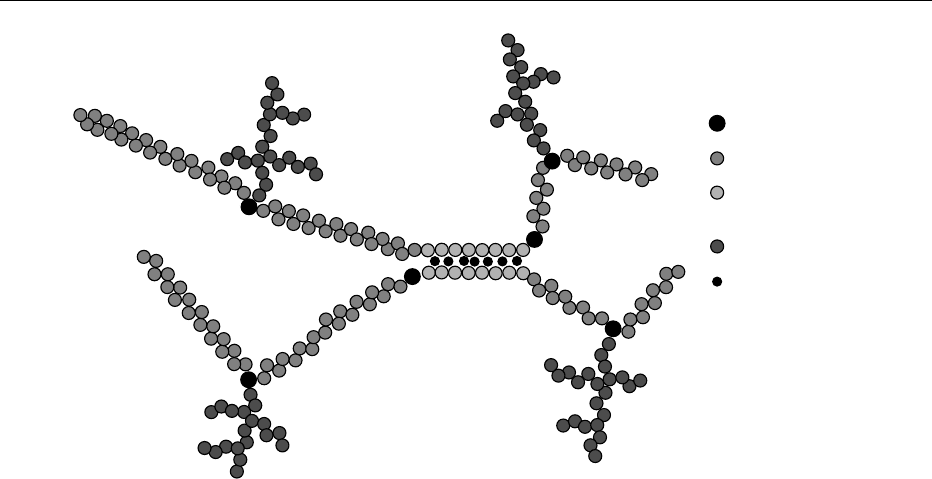
network and precipitation can occur. The optimum
pH for gelation is controlled by the degree of ester-
ification of the pectin as well as the soluble solids
content of the medium (Figure 6).
0035 Through their effect on the neutralization of the
pectin molecule, cations present in the system will
affect gelling. High ionic strength shifts the optimum
pH range towards higher values. This is particularly
visible with sodium ions. However, with ions such as
calcium or potassium that can bridge high-ester
pectin molecules in areas with a low density of ester,
there is a possible increase in junction zones. This
effect can become significant for high-ester pectin
with marked blockwise distribution of ester groups
(Figure 7).
0036 Water activity and sugar types Water activity and
sugar types will both affect the way hydrophobic
interactions can develop between the pectin mol-
ecules. As water activity is reduced, the hydrophobic
interactions are easier to form, causing faster gelling
to occur and the final gel strength to be increased.
0037 The commonest way of reducing water activity in a
food system is through the use of sugars. The effect of
sugars on hydrophobic interaction and so on gel
structure will be specifically linked to their molecular
conformation and their interaction with the neighbor-
ing water molecules (Figure 8).
0038 Influence of cooling rate and storage temperature
Cooling decreases molecular movement and allows
polymer molecules to interact at close distances. As
the cooling rate is increased, the gelation rate is also
increased. However, during rapid cooling and with a
low storage temperature, gelling can actually become
very slow, reflecting the difficult development of
hydrophobic interactions in these conditions. With
an intermediate cooling rate and temperature range,
hydrogen bonds and hydrophobic interactions
together can contribute to the build-up of a network
with the highest elasticity.
0039Properties of high-ester pectin gels Due to the nature
of the molecular interactions involved in high-ester
pectin gelation, gels made with these pectins will
typically not be thermo-reversible or shear-reversible.
When submitted to mechanical stress, the broken gel
will then show a high level of syneresis.
Gelling of Low-Ester Pectin
0040Low-ester pectin has traditionally been used for gel-
ling food products when the conditions required to
achieve a gel with high ester pectin were not met.
Recently however, low ester pectins have also found
applications in high sugar and low pH systems
because of their specific texture characteristics.
0041Though the same base mechanism applies, low
ester conventional and amidated pectin differ in
their gelling properties and offer a broad range of
functional properties.
0042Gelling mechanism The gelation of low-ester
pectins is the result of ionic linkage through calcium
bridges between carboxylic groups from two pectin
Marked block
structure
Rhamnose
Galacturonic acid
Methylated
galacturonic acid
Neutral sugar
Calcium
fig0007 Figure 7 Participation of calcium gelling in high-ester pectin gelation.
PECTIN/Properties and Determination 4445
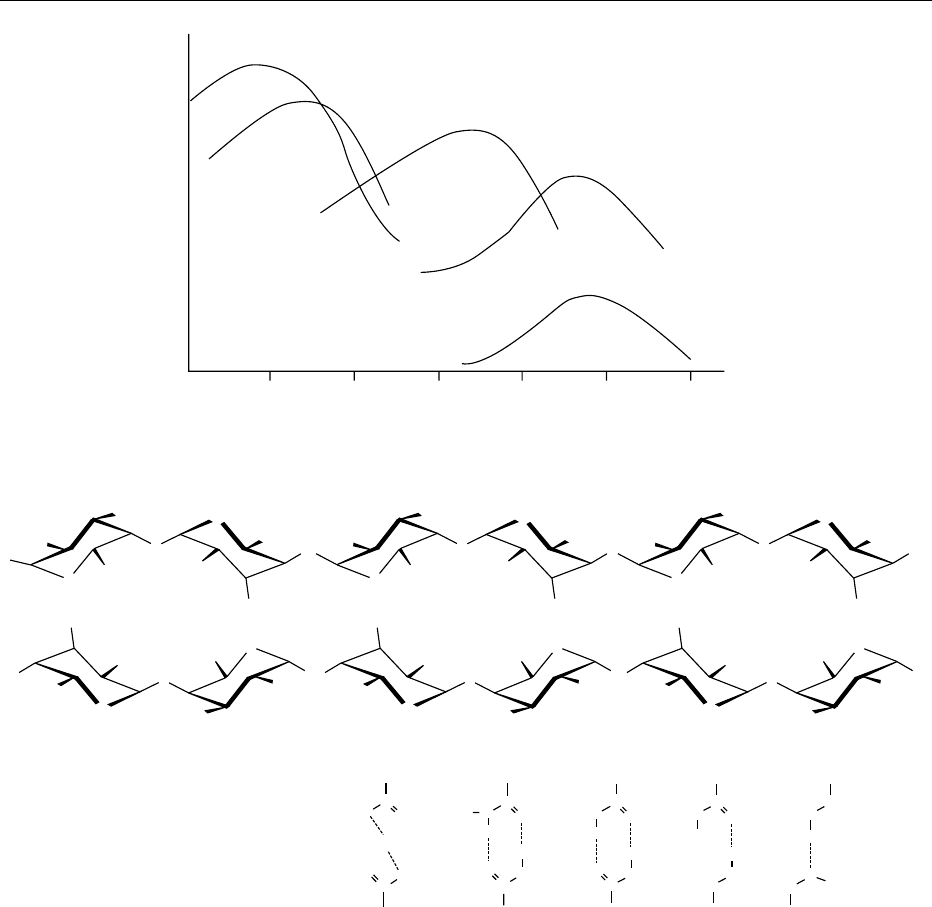
chains with the participation of hydrogen bonding.
The linkage generally takes place upon cooling a
pectin and calcium system. The most commonly
accepted model of association is the eggbox model
(Figure 9). In this model, pectin chains could be
bridged by calcium ions, which incorporate in their
coordination shells two polyanion oxygen atoms
from one pectin molecule and three from another
chain. Even though a number of positive ions can
bridge pectin molecules, especially magnesium and
potassium, calcium is particularly effective in com-
plexing with carbohydrates, largely because its ionic
radius (0.1 nm) is big enough to coordinate with
many oxygen atoms and because of flexibility with
regard to the direction of its coordinate bonds.
0043The exact calcium requirements to obtain a gel
highly depend on the degree of esterification of the
pectin, the recipe, and process parameters such as the
rate of cooling. An increase in ionic strength, increase
in pH, or decrease in the degree of esterification
lowers the amount of calcium required to achieve
sol–gel transition. An optimum calcium level can be
defined for a given pectin in specific conditions.
Above this optimum level, pregelation will occur,
i.e., gelling will occur at too high temperatures to
obtain a coherent gel structure (Figure 10).
3.0 3.1 3.2 3.3 3.4 3.5 pH
High-fructose corn syrups
Sucrose
63 DE corn syrup
43 DE high-maltose corn syrup
42 DE corn syrup
Gel strength
fig0008 Figure 8 Effect of various sugars on high-ester pectin gel strength. DE, dextrose equivalent.
C
C
O
−
O
O
C
−
Ca
++
C
O
H
O
O
H
N
H
C
C
O
H
O
O
H
O
C
C
H
O
C
H
O
C
O
H
O
H
O
C
HO
O
−
OOC
COO
−
COO
−
OH
O
O
O
O
O
OH
OH
HO
HO
HO
COO
−
OH
O
Ca
++
HO
O
O
−
OOC
COO
−
COO
−
OH
O
O
O
O
O
OH
OH
HO
HO
HO
COO
−
OH
O
Ca
++
HO
O
O
O
O
−
OOC
COO
−
COO
−
OH
O
O
O
O
O
OH
OH
HO
HO
HO
COO
−
OH
O
Ca
++
fig0009 Figure 9 Eggbox model. Schematic overview of established low-ester pectin gel mechanism, showing calcium-induced junction
zones. Inset shows detail of the various types of possible hydrogen bonding that participate in the junction zone, together with the
calcium chelation (far left).
4446 PECTIN/Properties and Determination

0044 Gelling is dependent on the length of the junction
zones, that is, the number of galacturonic acid units
involved in electrostatic bonds with calcium. The
bonds are stable when at least seven consecutive
carboxyl groups from each chain are involved. If the
junction zones formed with calcium become too long,
a pectin precipitate may be formed. This may occur
with pectin with a very low degree of esterification
when large amounts of calcium are available.
0045 The presence of ester or amide groups prevents the
formation of junction zones in the interjunction seg-
ments of the molecules, making them more flexible.
Side chains also prevent aggregation of the pectin
molecules through steric hindrance.
0046 The typical high-ester pectin gelling mechanism
with hydrogen bonds and hydrophobic interactions
can also contribute to the final texture of low-ester
pectin gels, especially at low pH and with high soluble
solids concentration.
Parameters Influencing Gelling
0047 Although the availability of calcium is a critical factor
in the gelation of low-ester pectins, other parameters
in relation to the pectin molecule and media have a
significant influence on gelling and the final structure
obtained. The main parameters are the number and
distribution of ester and amide groups as well as the
molecular weight of the pectin molecule and the pH,
ionic strength, and water activity of the gelling
system.
0048 Influence of esterification Because calcium bonds
can only occur in esterification-free zones, gel
strength increases with a decreasing degree of esteri-
fication. For low-ester pectin with an average DE
above 30%, the distribution of the esters may be of
significant importance as it will control the length of
possible junction zones and influence the gelling
temperature, the final gel strength, and texture.
0049Influence of amidation The amidation of pectins
was developed in the 1940s as a means of modifying
the functional properties of low-ester pectins in order
to achieve better gelling control. The exact mechan-
ism by which the amide groups intervene in the
gelation remains to be fully explained. However, it
is generally accepted that amidation increases the
gelling power of low-ester pectins due to the possibil-
ity of hydrogen bonding involving amide groups. Gels
made with amidated pectins are firmer and require
less calcium; they are also more thermo-reversible
than ones made with low-ester conventional pectins.
0050Influence of molecular weight As for any polymer
gel, the length of the polymer governs the number of
junction zones required to achieve a coherent net-
work. Low-ester pectins with a high molecular weight
will exhibit a higher gelation rate, lower calcium
requirements for gelling, and an overall more cohe-
sive and elastic gel structure with a reduced tendency
towards syneresis.
0051Influence of pH At low sugar content, as the pH is
decreased, the pectin molecules are neutralized with
protons, decreasing the probability of junction zones
forming with calcium. This translates into higher
calcium requirements and a looser gel texture at a
low pH.
0052On the other hand, when the water activity of the
system is decreased by the addition of sugars, the
high-ester pectin gelling mechanism will start to play
a significant part in the gelling and the calcium
requirements will then be decreased when the pH is
lowered. In usual food systems, availability of natural
calcium will also be increased at a lower pH and thus
may reduce the need for extra calcium addition
(Figure 11).
0053Influence of ionic strength An increase in gel
strength can be observed at a higher ionic strength.
This is usually explained by the neutralization of the
polymers by the extra ions, which allows the chains to
be closer, leading to a more organized and cohesive gel.
0054Influence of water activity As the solids level
increases, calcium requirements decrease. However,
for most pectins, a higher solids level accelerates gel-
ling, and increases the setting temperature and the
final gel strength. It also reduces the optimum cal-
cium window, thus increasing the risk of pregelation.
0 20406080100
Low-ester amidated
pectin
Low-ester
conventional pectin
Gel strength
mg Ca
2+
g
−1
pectin
fig0010 Figure 10 Influence of calcium on low-ester pectin gels.
PECTIN/Properties and Determination 4447
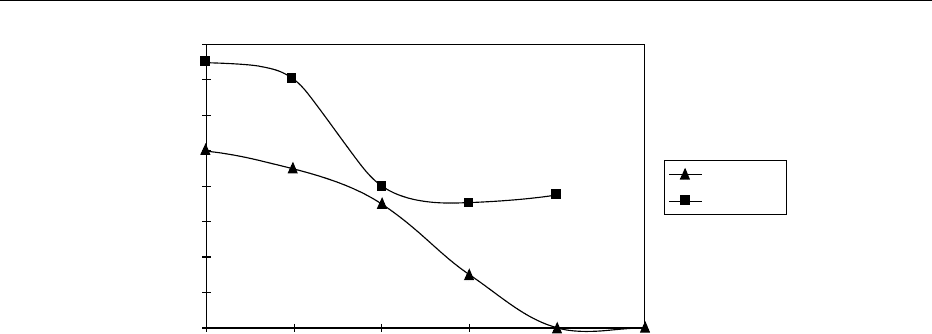
In practice, this leads to a choice of pectin with a
higher degree of esterification (less calcium-reactive)
at a higher solids level.
Properties of Low-Ester Pectin Gels
0055 The properties of low-ester pectin gels are very de-
pendent on the type of pectin used (conventional or
amidated) along with the procedure and formulation
employed to make the gel. Typically, they are thermo-
reversible and show a high degree of thixotropy. In
specific conditions it is however possible to obtain
heat-resistant or very brittle gels with no shear revers-
ibility.
Protein Stabilization with High-Ester Pectins
0056 In acidified conditions, casein and, more generally,
food proteins will tend to agglomerate and sediment
if the viscosity of the system is low enough. In these
conditions the proteins are also very sensitive to
dehydration and can easily become sandy after heat
treatment. With the rapid development of acidified
dairy beverages worldwide, now expanding with
other protein sources such as soy, the need for effect-
ive protein stabilizers in a low-pH environment is
growing strongly. High-ester pectin has proven to be
a very useful stabilizer in these conditions.
0057 Mechanism It is generally accepted that, at suffi-
cient pectin concentrations, the adsorption of the
carboxyl blocks of the pectin molecule to the protein
surface will stabilize the protein system through steric
repulsion (Figure 12). So, the presence of blocks of
free carboxyl groups on the galacturonic backbone
has an important influence on the protein-stabilizing
property of pectin.
0058Due to the lower proportion of carboxyl groups,
high-ester pectin has a weaker electrostatic inter-
action with protein than low-ester pectin but proves
to be more effective. Indeed, it seems to be important
that significant parts of the pectin molecule do
not interact with the protein surface in order to
achieve the steric repulsion effect. It is also the key
to minimizing interactions between pectin and
cations available in the system.
0059Both the DE of the pectin and the distribution of
the esters on the polymer affect its stabilization prop-
erties. Excessively large blocks of carboxyl groups
will tend to interact with the ions present in the
system, such as calcium, rather than with the protein
– an interaction which will lead to an increase in
viscosity or even gelation.
0060Conditions Most food proteins (isoelectric point
around 5) can form complex coacervates with anionic
polysaccharides such as pectin (isoelectric point
around 3.5) in the intermediate-pH region, where
the two macromolecules carry opposite net charges:
pH above the isoelectric point of the polysaccharide
but below that of the protein.
0061In the case of pectin–protein interaction, the
strength of the complex will depend on several
factors, such as the distribution of the carboxyl
groups on the galacturonic acid backbone, but also
on the three-dimensional protein structure and the
distribution of ionizable groups on its surface. The
whole interaction will also depend on several system
parameters such as pH, ionic strength, presence of
sugars, or fat.
0062Through its role in the ionization of both the protein
and pectin molecules, pH is the most significant factor
affecting electrostatic pectin–protein interactions. It
3.10
0
20
40
60
80
100
120
140
160
3.30 3.50 3.70 3.90 410
pH
Breaking strength (g)
100 mg Ca
200 mg Ca
fig0011 Figure 11 pH influences on Ca-curves in low-sugar system (31% soluble solids), with high reactive amidated pectin. Triangles,
100 mg Ca; squares, 200 mg Ca.
4448 PECTIN/Properties and Determination
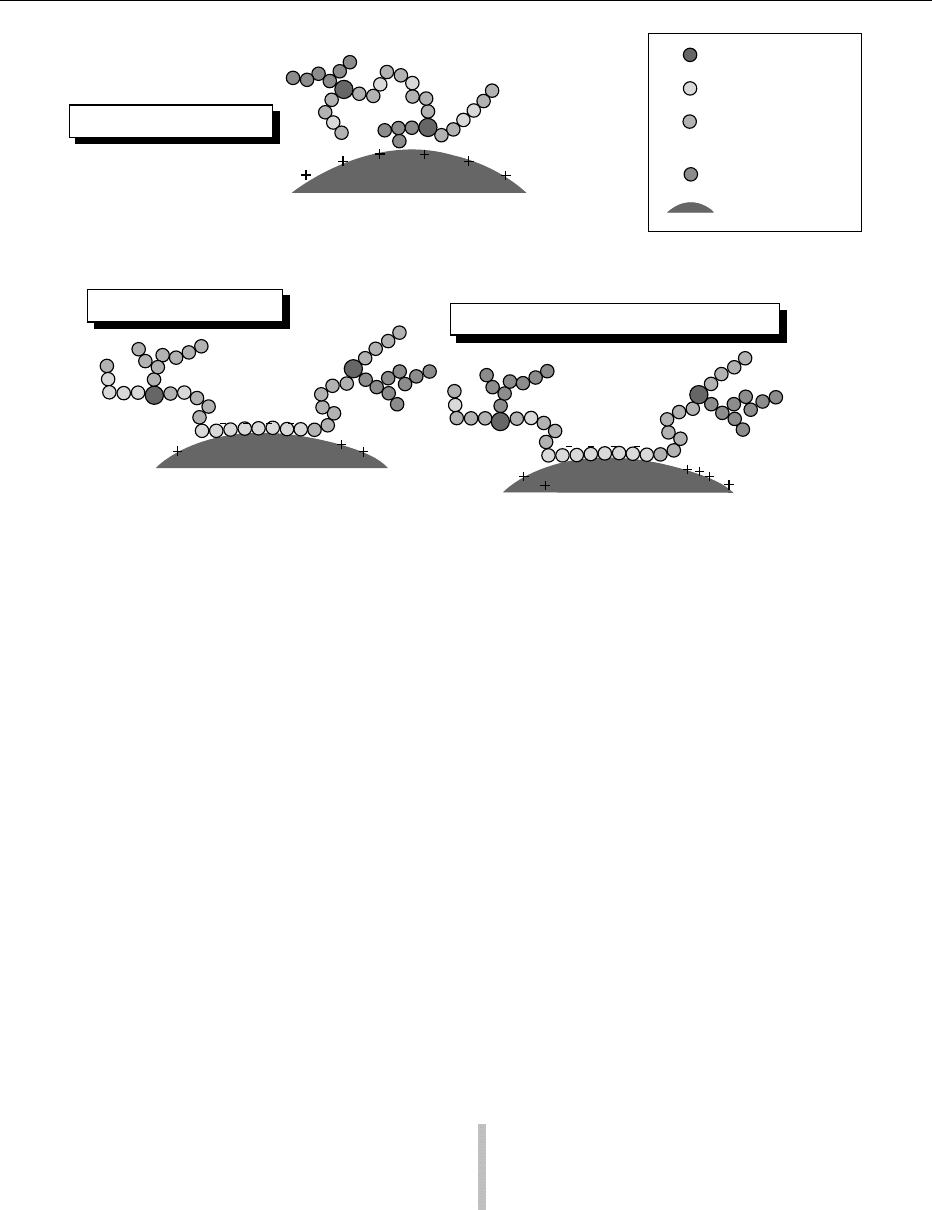
also plays a very significant role in the protein struc-
ture and how proteins interact in a complex system
such as milk.
0063 The optimum pH range for interaction between
high-ester pectin and casein is 3.6–4.5. At a lower
pH, the block structures of the high-ester pectin
will not be sufficiently ionized for proper protein
binding as the pH is too far below the pKa of the
pectin. Above the isoelectrical point of the protein,
the protein–polysaccharide complex is very weak or
nonexistent and the electrostatic protein–protein
repulsion is dominant. It is, however, clear that
this repulsion is not sufficient to stabilize the proteins.
Conclusion
0064 Pectin exhibits a wide range of functional properties
and enjoys a very good public image as a natural
product derived from fruit. Today it is widely used
as a textural ingredient and stabilizer in a variety of
food applications, and there is little doubt that its
usage will grow as new functionalities are revealed.
See also: Cholesterol: Absorption, Function, and
Metabolism; Citrus Fruits: Composition and
Characterization; Dietary Fiber: Physiological Effects;
Fermented Milks: Types of Fermented Milks; Gums:
Properties of Individual Gums; Food Uses; Dietary
Importance; Jams and Preserves: Methods of
Manufacture; Chemistry of Manufacture; Pectin: Food
Use; Protein: Interactions and Reactions Involved in Food
Processing; Rheological Properties of Food Materials;
Rheology of Liquids; Stabilizers: Types and Function;
Applications
Further Reading
Dickinson E (1998) Stability and rheological implications
of electrostatic milk protein–polysaccaride interactions.
Trends in Food Science and Technology 9: 347–354.
Kravtchenko TP, Voragen AGJ and Pilnik W (1994) Char-
acterization of industrial high methoxyl pectins. Gums
and Stabilizers for the Food Industry 7: 27–35.
May CD (1990) Industrial pectins: sources, production and
application. Carbohydrate Polymers 12: 19–99.
Rolin C and De Vries J (1990) Pectin. In: Harris P (ed.) Food
Gels, pp. 401–434. London: Elsevier.
Thakur BR, Singh RK and Handa AK (1997) Chemistry
and uses of pectin – a review. Critical Reviews in Food
Science and Nutrition 37: 47–73.
Walter RH (ed.) (1991) The Chemistry and Technology of
Pectin. London: Academic Press.
Food Use
L Flutto, Danisco, New Century, KS, USA
Copyright 2003, Elsevier Science Ltd. All Rights Reserved.
Introduction
0001Pectin has been used traditionally in food ever since
man started cooking fruits and vegetables. As a
Lack of binding sites
Optimal binding site
Marked block
structure
Hairy surface provides steric stabilization
Rhamnose
Galacturonic acid
Methylated
galacturonic acid
Neutral sugar
Part of casein
fig0012 Figure 12 Theoretical picture of interaction between pectin and protein.
PECTIN/Food Use 4449

natural component of plants, pectin is a desirable
texturizing and stabilizing agent for use in all kinds
of processed foods available today. In this chapter, we
take a brief look at the most important food uses of
pectin and its key properties in each system.
Function in Foods
0002 Pectin is traditionally used for its gelation properties,
with more than a third of the pectin commercially
available being utilized by the jam and jelly industry.
Pectin is used to ‘set’ or gel jams, jellies, and pre-
serves. The pectin holds fruit pieces suspended within
the gel structure, trapping water between cross-linked
pectin molecules. The result is a gelled food that is
shelf-stable. However, in more complex applications
such as fruit preparations for dairy products, pectin
is used to impart specific rheological properties
during the manufacturing and storage of the fruit
preparation, as well as during blending with the
dairy product and all during the shelf-life of the fin-
ished product. Pectin is also widely used for its unique
protein stabilization properties in acidic conditions.
The general acceptance of pectin as a natural material
and a soluble food fiber has made it desirable for use
in a variety of applications (Table 1).
Jams and Jellies
0003 Jams, jellies, and preserves can be divided into two
categories. Traditional products have a solids range
usually above 60%. Reduced sugar products have a
soluble solids content in the range of 25–55%.
0004 High-ester pectins are used in the production of
jams, jellies, and preserves with soluble solids above
60% and a pH below 3.6. As high-ester pectin gels
are not shear-reversible, it is of utmost importance
that the jars be filled at a temperature above the
setting temperature of the pectin in order to avoid a
broken gel and syneresis. Various high-ester pectins
used in recipes with different soluble solid contents
will have different optimum pHs (Figure 1).
0005The choice of pectin will also be dependent on
the type of product made. A fast-setting pectin is
preferred for preserves where fruit pieces have to be
suspended evenly throughout the container. By con-
trast, a slow setting pectin is used for jellies in order
for air bubbles to escape prior to gelling, resulting in a
fully transparent product. The size of the packaging
will also influence the choice of pectin, with fast-
setting pectin recommended for larger jars, as the
cooling rate is slower, and a quick gelling is necessary
to keep the fruit pieces in place. It is important,
however, to note that for very large containers
(several kilograms to several hundred kilograms), it
is necessary to cool down the product before filling as
the cooling rate is too slow in the center of the prod-
uct, and the pectin is degraded when exposed to high
temperatures for an extended time. In this case, a
slow-set pectin or even a low-ester pectin is required
to allow for cooling prior to filling without breaking
the gel network. When filling in small packages and
especially in food-service single-serve packages, the
use of a slow-set pectin is also required as the filling
time can be quite long. The temperature of the prod-
uct in the holding tank before the packaging line will
need to be reduced to avoid pectin degradation in
time and insure consistent gelling from the first to
the last package of the batch. Low-ester pectins are
used when conditions for gelling a high-ester pectin
are not met. Typically, this is the case when the sugar
content is reduced below 60%. They are, however,
also used in high-soluble-solids formulations when a
tbl0001 Table 1 Function of pectin in food applications
Function Food application Typical use
level (%)
Viscosity building Juice beverage, soft drinks 0.01–0.20
Sauces 0.10–0.50
Sorbet (avoids crystallization) 0.10–0.40
Protein stabilization Yogurt drinks 0.15–0.60
Milk–Juice drinks 0.15–0.60
Acidified soy drinks 0.20–0.60
Gelation Jams, jellies, preserves 0.30–1.20
Fillings, glazes 0.30–1.20
Desserts 0.50–1.00
Confectionery 0.50–2.50
0
2.5 3.0
p
H
Gel strength
3.5
65% soluble solids
60% soluble solids
RS pectin
SS pectin
SS pectin
RS pectin
fig0001Figure 1 Choice of high-ester pectin and slow-set pectin (SS)
content to determine the optimal pH for the gelation. RS, rapid
set.
4450 PECTIN/Food Use

spreadable texture is desired. These pectins gel in the
presence of calcium ions, which is the main factor
controlling the gelling. The soluble solids level and
pH are only secondary parameters, but they have an
influence on the gelling temperature and the texture.
0006 As the soluble solids are decreased, the greatest
challenge for the manufacturer is to keep an even
distribution of fruit pieces. Indeed, the main influence
of the soluble solids level will be on the viscosity of
the jam at high temperatures during the process.
0007 The choice of a low-ester pectin is therefore mostly
based on the solids level. The use of low-ester ami-
dated pectins with increasing calcium reactivity is
usually recommended when the soluble solids are
decreased. This insures a faster set with an even dis-
tribution of fruits. In low-brix formulations, the add-
ition of calcium may be required to supplement the
calcium brought by the fruits and the water and to
insure a fast and homogeneous gelling.
0008 To further avoid the flotation issues, a combination
of low-ester amidated pectin and conventional pectin
is commonly used. The low-ester conventional
pectin forms a network at a higher temperature than
the amidated counterpart and helps to keep the fruit
well distributed. Other gums such as locust bean gum
or guar are also often used in combination with a
low-ester pectin to provide viscosity in low-solids
formulations (Table 2).
0009A rapidly growing category in jams and jellies field
is products where refined sugars have been replaced
by fruit-juice concentrates. These products usually
have between 40 and 50% soluble solids and rely on
low-ester pectin gels. The only difference with stand-
ard reduced sugar recipes is in the ionic balance, as
the fruit concentrates add a significant amount of
calcium, as well as magnesium and potassium, to
the formulation. This influences the choice of pectin
as well as the amount of calcium to be added to the
product. It is important to position the product on the
flat part of the calcium curve and use a pectin with a
broad tolerance to calcium in order to obtain a con-
sistent texture, despite the usual variations in calcium
content of the natural raw materials (Figure 2).
Fruit Preparations
0010The fruit preparation industry constantly juggles be-
tween retaining the identity of the fruit, perfect fruit
tbl0002 Table 2 Typical reduced-sugar jam formulations with a low-ester amidated pectin
Jam final soluble solids content
25% 35% 45%
Ingredients Dosage
(%)
Soluble
solids (%)
Dosage
(%)
Soluble
solids (%)
Dosage
(%)
Soluble
solids (%)
High-calcium reactive low-ester amidated pectin 0.8 0.8 0.7 0.7
Medium-calcium reactive low-ester amidated pectin 0.6 0.6
Locust bean gum 0.1 0.1
Sugar I 3.6 3.6 2.8 2.8 2.4 2.4
Water I 18.0 14.0 12.0
Fruit, 10% soluble solids 45.0 4.5 45.0 4.5 45.0 4.5
Sugar II 15.9 15.9 26.9 26.9 37.4 37.4
Water II 21.1 15.1 7.1
K-sorbate, 20% w/v 0.2 0.04 0.2 0.04 0.2 0.04
Na-benzoate, 20% w/v 0.3 0.06 0.3 0.06 0.3 0.06
Citric acid, H
2
O, 50% w/v As required As required As required
Flavoring As required As required As required
Total 105.1 25 105.1 35 105.1 45
Evaporation 5.1 5.1 5.1
Yield 100.0 100.0 100.0
pH 3.2 3.2 3.2
Filling temperature (
C) 40–50 45–55 55–65
Procedure (regardless of targeted soluble solids)
1. Dry-blend the low-ester pectin (the locust bean gum if present) and sugar I, and add the blend to 80
C hot water I, agitating
vigorously
2. Mix fruit, sugar II and water II and heat the blend to approx. 80
C
3. Add the pectin solution, agitating continuously
4. Evaporate to the desired content of soluble solids
5. Add preservatives and adjust pH with citric acid
6. Add flavoring
7. Cool to filling temperature and fill
PECTIN/Food Use 4451

distribution throughout large totes, unique formula-
tions able to accommodate fruits with a varying
calcium content, and the texture and flavor of the
final dairy product in which the fruit preparations
are used. These challenges, combined with the pres-
sure on manufacturers to develop new fruit prepar-
ations quickly and the need to create process-friendly
formulations, call for the use of highly functional and
versatile stabilizers. Pectin has found a natural appli-
cation in these systems and is widely used.
Use of Pectin in Fruit Preparations
0011 Pectin is used in fruit systems for various purposes.
However, fruit preparations should only be thickened
and not fully gelled. This requires pectin capable of
giving fruit preparations a high degree of thixotropy.
0012 The texture of the fruit preparation can be con-
trolled by various parameters, as outlined in Table 3.
Use of a High-ester Pectin
0013 When more than 55% soluble solids are used, a high-
ester pectin with a typical dosage of 0.3% can
successfully impart viscosity and control syneresis in
a fruit preparation.
0014It is also possible to use a high-ester pectin with less
than 55% soluble solids in order to yield a special
texture. In these cases, a high-ester pectin typically
gives the fruit preparation a high degree of shine and
smoothness, although higher dosages are necessary.
0015Special high-ester pectins developed for their inter-
action with casein can also be used to obtain a high
degree of texture carry-through in the white mass. At
a usage level of 1–2%, the pectin gives the fruit
preparation the required texture and significantly
increases the viscosity of the finished stirred yogurt.
It also helps maintain a constant viscosity and reduce
syneresis during the shelf-life of the dairy product
(Figure 3).
Use of a Low-ester Pectin
0016Conventional and amidated low ester pectins are
widely used in fruit systems. While conventional
pectins require a slightly higher dosage and high
level of calcium, special ones have extreme processing
flexibility and can be used with great success in a
broad variety of formulations from 30 to 50 Brix
with various pH values. It is common to include low
ester conventional pectin in fruit on the bottom for-
mulations. Low-ester amidated pectin can prove
more economical with the possibility of lower
dosages, although it tends to be more sensitive to
calcium variations (see Figure 2). When the calcium
level is adjusted, it is possible to achieve an excellent
fruit suspension with a high level of shear reversibil-
ity. This allows low viscosity during pumping for
maximum fruit identity.
Calcium Addition for Texture and Postreaction
Control
0017When using a low-ester pectin, it is usually necessary
to add calcium salts to obtain the full texture. The
necessary quantity will depend on the calcium source,
pH, soluble solids, fruit type, and content of the
preparation. Specific calcium salts should be selected
according to the speed of release and labeling consid-
erations. Calcium chloride, -lactate, and -citrate is
Gel strength
Low-ester amidated
pectin
Low-ester
conventional pectin
0 20406080100
Milligrams of Ca
2+
per gram of pectin
fig0002 Figure 2 Low-ester-pectin calcium curves.
tbl0003 Table 3 Parameters influencing the texture of fruit preparations
Choice of pectin High-ester, low-ester conventional, and low-ester amidated pectins perform differently and allow a
variety of textures
Pectin dosage A higher pectin dosage results in a thicker texture
Calcium level The calcium level needs to be adjusted with consideration for a possible reaction in the white mass;
higher calcium levels usually increase viscosity, but pregelation can occur if too much calcium is
added
Soluble solids Higher soluble solids usually result in a shorter texture
Filling temperature Lower filling temperatures usually result in a more fluid texture
Use of other hydrocolloids Locust bean gum, guar gum, xanthan gum and starches can be successfully used in combination with
pectin to achieve specific textures
4452 PECTIN/Food Use
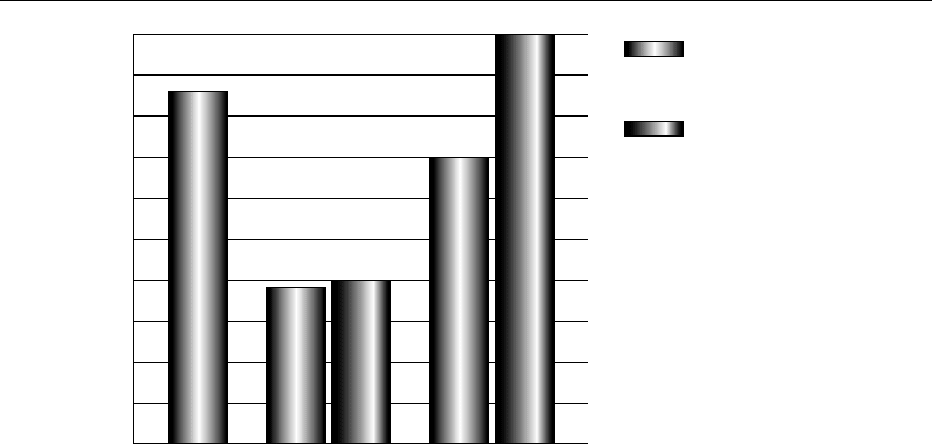
most commonly used to supplement the calcium
contained in the fruit.
0018 If the calcium content of the fruit preparation is too
low, the pectin present in the fruit preparation may
react with the calcium of the yogurt, resulting in a
grainy texture (stirred yogurt) or a gelled preparation
(fruit on the bottom). To avoid this type of postreac-
tion, it is highly recommended that the appropriate
amount of calcium is added to the fruit preparation.
Bakery Fillings
0019 In principle, bakery fillings are a form of fruit prepar-
ation. However, they deserve a separate paragraph as
the demands on these products are fairly specific.
Applied on or inside the dough, they usually need to
be heat-resistant and have a level of water activity low
enough to minimize water transfer from the filling
to the dough. This is especially important for long-
shelf-life cookies and cereal bars, which tend to be
where there is greatest demand. As is the case for fruit
preparations for the dairy industry, the trend is for the
bakeries to outsource the production of fillings and
transport them in larger containers.
0020 Most bakery fillings have a high solids content
typically between 60 and 80%. Thus, a high-ester
pectin seems a natural choice also because these gels
are thermally irreversible. However, high-ester pectin
gels are completely nonthixotropic and lose their
entire structure after pumping. So, pure high-ester
pectin gels, which require cooling prior to filling and
mechanical pumping at the bakery, are not adequate
for packaging in large containers. High-ester pectin
gels would be destroyed by such processes and show
syneresis and a very poor bake stability.
0021High-ester pectins may, however, be used success-
fully for cold gelation systems, also called delayed
setting systems. These are gel systems in which all
the gelling conditions for a high-ester pectin are met,
with the exception of the pH, which is kept too high.
This viscous syrup can then be shipped to the bakery,
where the acid is then added upon depositing the
filling on the dough.
0022For other types of bake-stable fillings, specific low-
ester pectins can prove ideal. Even if low-ester pectin
gels are typically characterized as being thermally
reversible (a property used in glazes), they can be
made bake-stable by using an optimized formulation.
Low-ester conventional pectins are usually preferred,
as they show a higher bake stability due to a stronger
binding with calcium. The choice of the correct
calcium salt as well as its dosage is the key to both
the texture of the filling and its heat stability. In very
high solids formulations, the use of pectin in combin-
ation with alginate can prove useful in improving the
filling appearance and its bake stability.
Glazes and Bakery Decor
0023Glazes are widely used to cover fruit tarts and
other types of cakes where they not only add con-
sumer appeal but also extend shelf-life by forming a
Fruit preparation with
30% soluble solids
Fruit preparation with
55% soluble solids
Yogurt
white base
Yogurt with
reference
fruit preparation
Yogurt with
fruit preparation
made with special hi
g
h-ester pectin
Viscosity of yogurt (mPas)
7 days after fruit-preparation addition
fig0003 Figure 3 Use of a special high-ester pectin in a fruit preparation to increase the viscosity of yogurt.
PECTIN/Food Use 4453

barrier to dehydration and microbiological contamin-
ation. The high transparency and shine of pectin gels
make the use of this hydrocolloid an ideal choice for
this application. In some specific applications, it is
possible to use combinations of pectin with alginate
or carrageenan.
0024 Contrary to most bakery fillings, in glazes and
bakery decorations, the heat reversibility of the
system is usually of paramount importance. These
products are most often sold to bakery shops in con-
centrated form and reheated and diluted with water
before application. The gel must then form quickly
and keep for several days, even on fruits with a high
water content. In industrial applications, the gel has
to be so completely reversible such that the product
can be sprayed. Clearly, these requirements are best
met with low-ester amidated pectins.
0025 The use of specific calcium sources with controlled
release together with calcium sequestrants is neces-
sary to control the gelling of a low-ester pectin and
secure an optimum performance after reheating.
Confectionery
0026 Pectin is widely used in traditional confectionery
items such as ‘pa
ˆ
te de fruit,’ or Zefir. However, it is
also an important textural agent in a number of other
confectionery articles, where its superior flavor
release, high transparency, and clean bite are sought
after.
0027 Jelly candies typically have a soluble solids content
of between 75 and 80% and a pH of around 3.5. Due
to the high solids level, it is important to use a very
slow setting high ester pectin and include buffer salts
in the formulation to avoid any pre-gelling before
depositing.
0028 The standard process usually involves making a
pectin solution with the buffer salts, heating the
sugars and fruits when present, and mixing in the
pectin solution before cooking to reduce the water
level and obtain the desired solids content. Immedi-
ately before depositing, acid, color, and flavorings are
added. Pectin jellies can be deposited in starch or
rubber molds or in large trays for further cutting. It
is also possible to use pectin on jet cooking equipment
where all the ingredients are mixed together, and the
pectin actually dissolves at a very high temperature
(around 140
C) with all the solids present. This pro-
cedure usually requires the use of specific pectins with
particular dissolution properties.
0029 In most cases, the pectin chosen for confectionery
will be an extra-slow setting type to guarantee a low
setting temperature. Even with this type of pectin, the
gelling temperature of the system is usually around
80
C, and the depositing temperature needs to be
above this level if the full gelling potential of the
pectin is to be used. This is a major difference from
the commonly manufactured gelatine candies, which
have a much lower setting temperature. Another sig-
nificant difference is the speed of gelation, as pectin
jellies can be demolded quickly after depositing since
a firm gel is obtained very quickly. As with all high-
ester pectin gels, typical pectin jellies are not ther-
mally reversible.
0030The buffer salts commonly used with pectin in
confectionery include sodium citrate and sodium
potassium tartrate. The latter tends to give the jellies
a somewhat firmer texture.
0031High-ester pectin is also often used in combination
with other ingredients such as gelatine, starch, or agar
to give intermediate textures. In the case of gelatine
candy, pectin is also used in small amounts to increase
the melting point of the confectionery pieces in warm
climates, thus insuring a better appearance through-
out their shelf-life without significantly affecting the
texture.
0032In specific candy pieces where a neutral flavor such
as vanilla is used, the use of a low-ester pectin is
necessary in order to obtain a gel at a higher pH. As
with high-ester pectins, it is usually necessary to reduce
the setting temperature. In these systems, calcium
sequestrants such as sodium hexametaphosphate are
used. Turkish delight is one such traditional candy
based on a low-ester pectin gel with or without the
addition of starch.
0033High- and low-ester pectins are also widely used
for confectionery fillings, which are then either
enrobed usually with chocolate or, for example,
panned into jelly beans.
Fruit Beverages and Soft Drinks
0034Pectin is used as a viscosifier in beverages and soft
drinks, and high-ester pectins may be used as a mouth-
feel improver. This use has been widely developed for
juice drinks with a reduced juice content or sugar-free
soft drinks.
0035Low-concentration pectin solutions can be con-
sidered Newtonian and show a low viscosity. This is
of great relevance for the use of pectin in fruit bever-
ages and soft drinks as the concentration used rarely
exceeds 0.5%. Indeed, the clean mouth feel imparted
by pectin compared with the tendency towards a
slimy mouth feel with some other gums could be
related to the low viscosity of pectin solutions at the
shear rate applied in the mouth. This property makes
pectin an ideal choice when trying to replace the
mouth feel lost by the reduction in sugar content.
0036As most juice beverages and soft drinks contain
calcium, pectin with a high degree of esterification is
4454 PECTIN/Food Use
